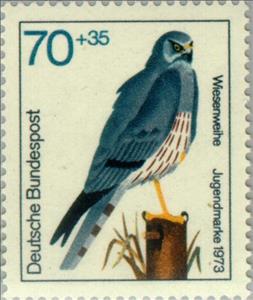Stamp: Montagu's Harrier (Circus pygarus) (Germany, Federal Republic 1973)
Montagu's Harrier (Circus pygarus) (Germany, Federal Republic 1973)
06 February (Germany, Federal Republic ) within release Birds goes into circulation Stamp Montagu's Harrier (Circus pygarus) face value 70+35 German pfennig
| Stamp Montagu's Harrier (Circus pygarus) in catalogues | |
|---|---|
| Michel: | Mi:DE 757 |
| Yvert et Tellier: | Yt:DE 607 |
Stamp is vertical format.
Also in the issue Birds:
- Stamp - Osprey (Pandion haliaeetus) face value 25+10;
- Stamp - Common Buzzard (Buteo buteo) face value 30+15;
- Stamp - Red Kite (Milvus milvus) face value 40+20;
- Stamp - Montagu's Harrier (Circus pygarus) face value 70+35;
Stamp Montagu's Harrier (Circus pygarus) it reflects the thematic directions:
Birds (Aves), a subgroup of Reptiles, are the last living examples of Dinosaurs. They are a group of endothermic vertebrates, characterised by feathers, toothless beaked jaws, the laying of hard-shelled eggs, a high metabolic rate, a four-chambered heart, and a strong yet lightweight skeleton. Birds live worldwide and range in size from the 5 cm (2 in) bee hummingbird to the 2.75 m (9 ft) ostrich. They rank as the class of tetrapods with the most living species, at approximately ten thousand, with more than half of these being passerines, sometimes known as perching birds. Birds are the closest living relatives of crocodilians.
Birds of prey or predatory birds, also known as raptors, are hypercarnivorous bird species that actively hunt and feed on other vertebrates (mainly mammals, reptiles and smaller birds). In addition to speed and strength, these predators have keen eyesight for detecting prey from a distance or during flight, strong feet with sharp talons for grasping or killing prey, and powerful, curved beaks for tearing off flesh. Although predatory birds primarily hunt live prey, many species (such as fish eagles, vultures and condors) also scavenge and eat carrion
Animals are multicellular, eukaryotic organisms of the kingdom Animalia (also called Metazoa). All animals are motile, meaning they can move spontaneously and independently, at some point in their lives. Their body plan eventually becomes fixed as they develop, although some undergo a process of metamorphosis later on in their lives. All animals are heterotrophs: they must ingest other organisms or their products for sustenance.



